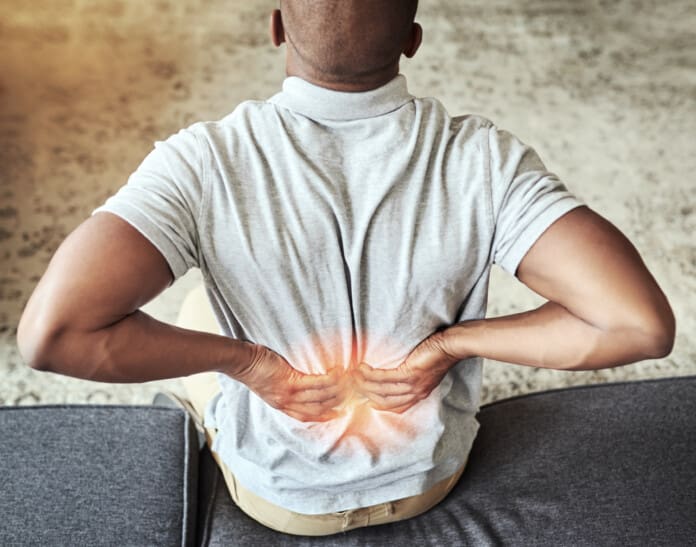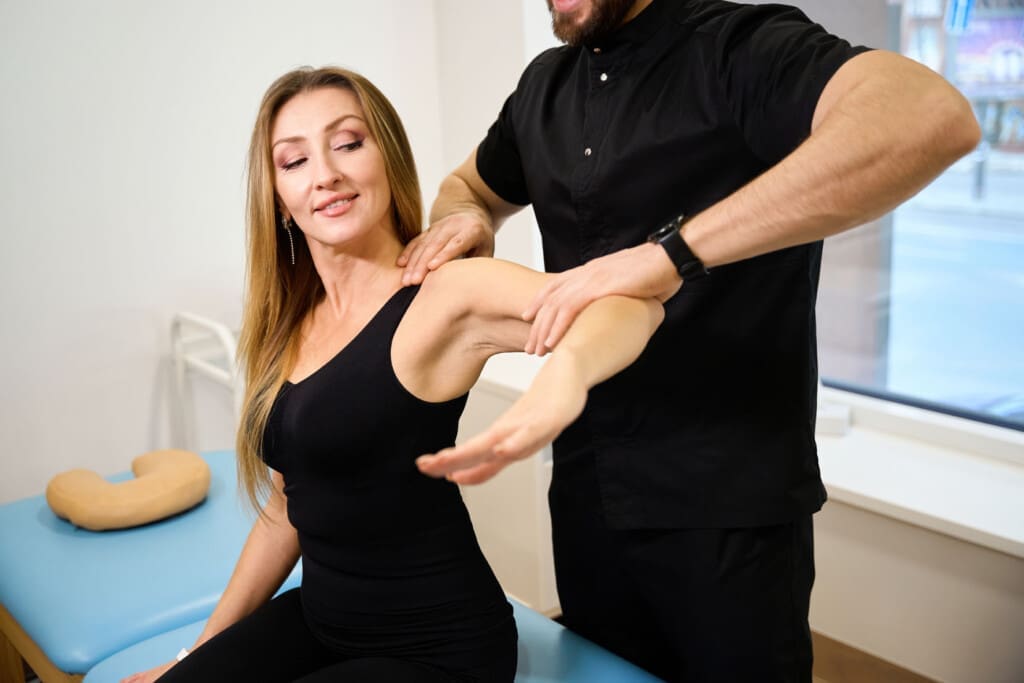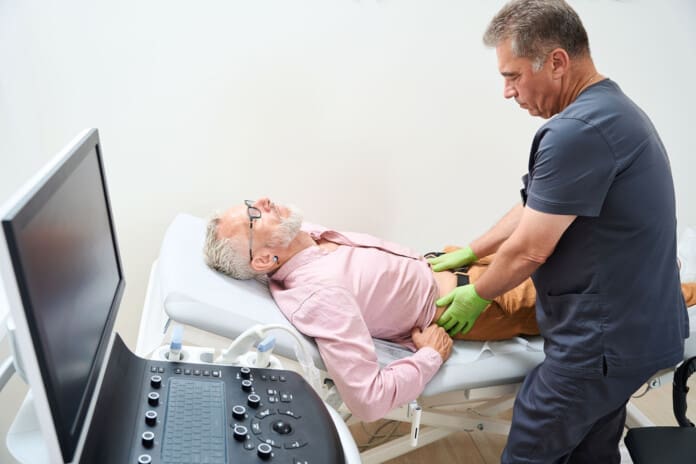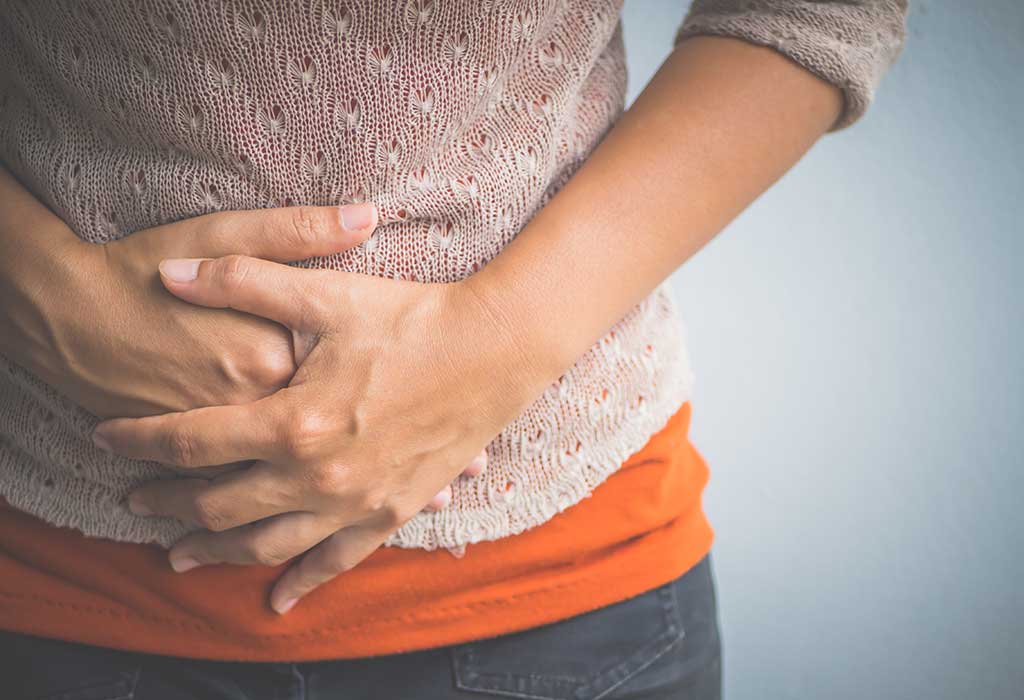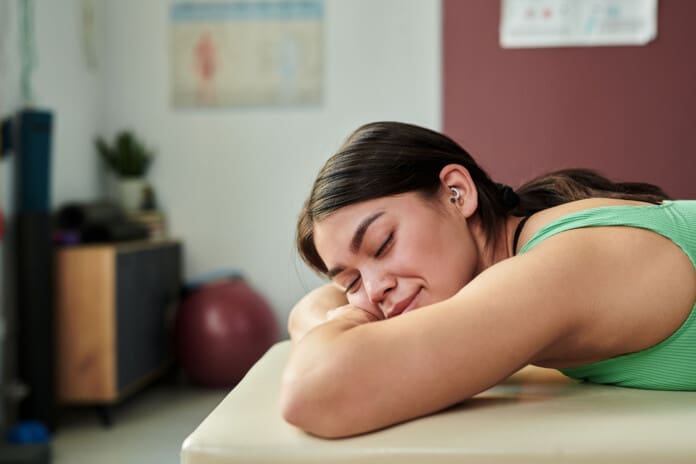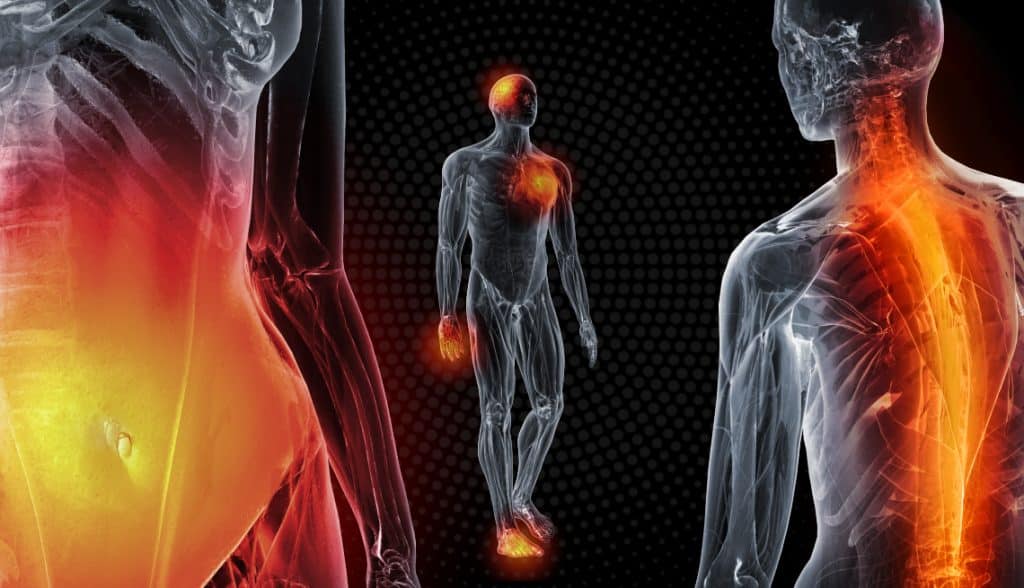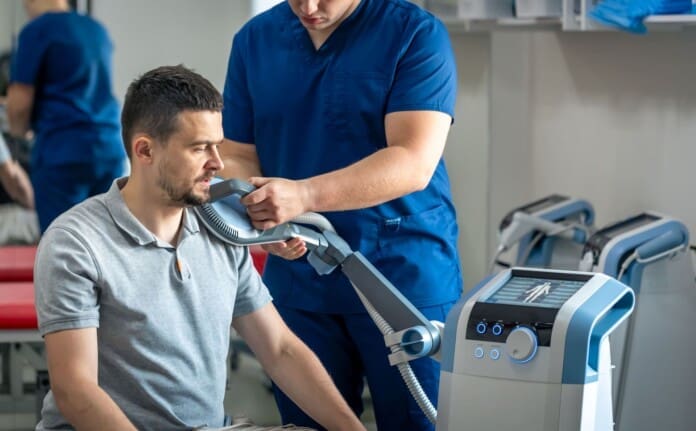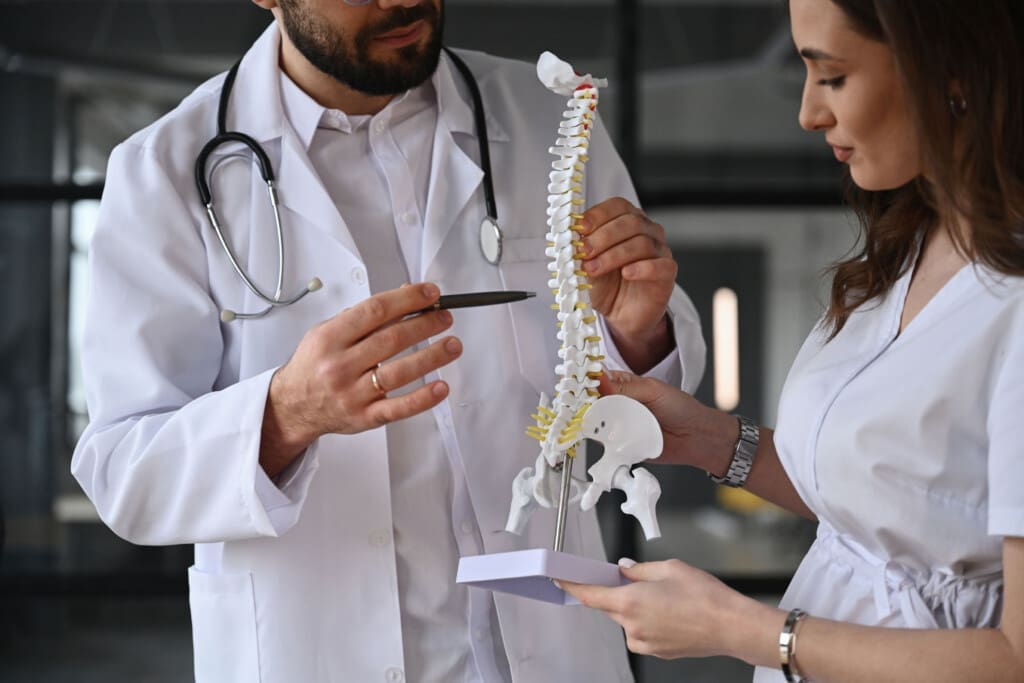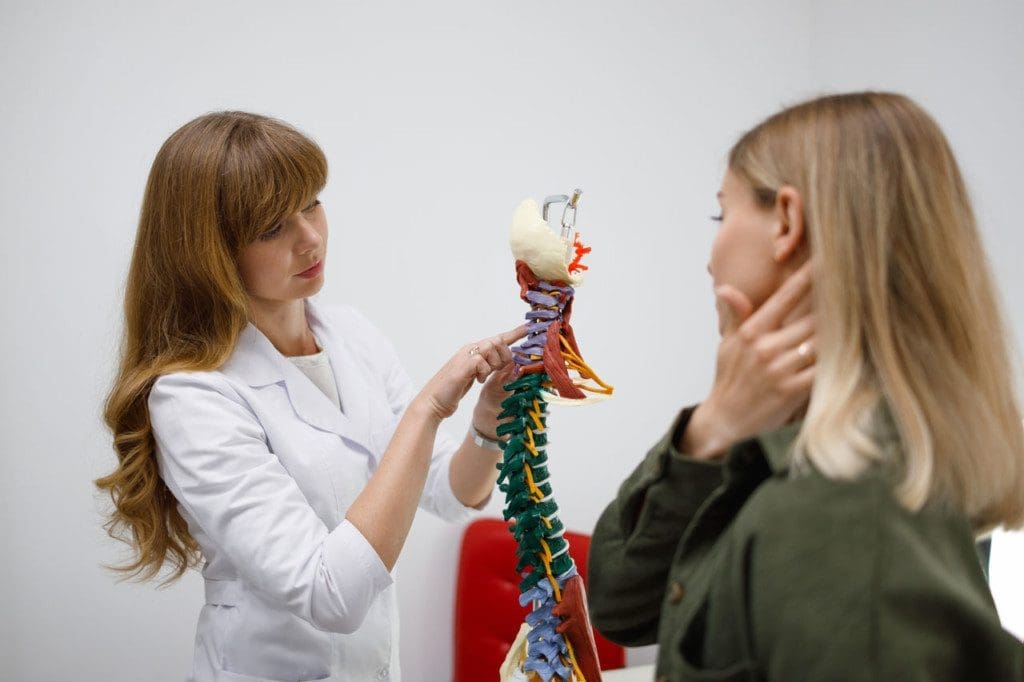Discover solutions with chiropractic care for herniated discs that specifically target pain relief and enhance your physical well-being.
Chiropractic Care for Low Back Pain and Herniated Discs: A Comprehensive Guide
Mon cher, picture this: a spine as twisted as my tango with Morticia, yet with the right touch, it can glide back to harmony! Low back pain from herniated discs can feel like a pesky poltergeist haunting your daily routine, but fear not—chiropractic care, with its elegant adjustments and spinal decompression, offers a path to relief. In this comprehensive guide, we’ll explore why chiropractic care is a fantastic option for easing low back pain caused by herniated discs, delve into the role of the lumbar spine, and highlight how it impacts your life when things go awry. We’ll also spotlight the expertise of Dr. Alexander Jimenez, DC, APRN, FNP-BC, a distinguished chiropractor and nurse practitioner in El Paso, Texas, who waltzes between medical precision and legal documentation to help personal injury victims. With a dash of Gomez Addams’ flair, we’ll keep it lively, but rest assured, this is a serious dive into spinal health. Let’s get started, mi amor!
Understanding the Lumbar Spine and Herniated Discs
The Lumbar Spine: The Backbone of Your Body
The lumbar spine, or lower back, is like the sturdy foundation of a haunted mansion—it supports everything above it while enduring constant pressure. Comprising five vertebrae (L1–L5), the lumbar spine is built to carry the weight of your upper body, making it the workhorse of your spine (American Academy of Orthopaedic Surgeons, 2025). These vertebrae are connected by intervertebral discs, which act like shock-absorbing cushions, allowing you to bend, twist, and move without your bones grinding like a creaky old door.
Each disc has two parts:
- Annulus fibrosus: The tough, outer ring, like the iron gates of the Addams Family estate.
- Nucleus pulposus: The soft, jelly-like center, as squishy as Pugsley’s pet octopus.
Together, these discs provide flexibility and stability, letting you dance through life (or at least walk to the kitchen). The spinal cord and nerve roots run through the spinal canal, sending signals from your brain to your muscles. When everything’s aligned, it’s a symphony of movement. But when a disc herniates, it’s like Uncle Fester flipping the wrong switch—chaos ensues.
What Is a Herniated Disc?
A herniated disc, sometimes called a “slipped” or “ruptured” disc, occurs when the nucleus pulposus pushes through a tear in the annulus fibrosus, much like Lurch accidentally bursting through a door (American Academy of Orthopaedic Surgeons, 2025). This is most commonly observed in the lumbar spine, particularly at the L4–L5 and L5–S1 levels, where the spine bears the greatest weight (Personal Injury Doctor Group, 2017). Imagine the disc as a jelly donut: if you squeeze it too hard, the jelly squirts out, pressing on nearby nerves and causing pain.
Herniated discs can result from:
- Wear and tear: Over time, discs lose water content and elasticity, making them prone to tears, like Morticia’s favorite lace gloves fraying with age.
- Sudden injury: Lifting heavy objects improperly or a car accident can cause a disc to rupture, much like Gomez’s enthusiastic fencing mishaps.
- Repetitive stress: Constant bending or twisting, like Wednesday’s relentless archery practice, can weaken discs.
- Genetics: Some folks inherit a predisposition to disc degeneration, as if the Addams Family curse extended to their spines (Personal Injury Doctor Group, 2017).
When a herniated disc presses on nerve roots, it can cause radiculopathy, leading to sharp, radiating pain, numbness, or weakness in the legs, often referred to as sciatica (Frymoyer, 1988). Oh, the agony, cara mia! This pain can make simple tasks like sitting or walking feel like a gothic torture chamber.
How Herniated Discs Disrupt Daily Life
A herniated disc in the lumbar spine can turn your daily routine into a grim fandango. The pain, often described as sharp or burning, may radiate from the lower back to the buttocks, thighs, or even feet, mimicking the path of the sciatic nerve (American Academy of Orthopaedic Surgeons, 2025). Here’s how it affects you:
- Sitting: Prolonged sitting, such as binge-watching The Addams Family, can intensify pain by compressing the disc further.
- Walking: Pain or numbness in the legs can make strolling feel like wading through a swamp with Thing on your shoulder.
- Bending or Lifting: These movements strain the spine, making tasks like picking up groceries or tying your shoes as daunting as facing Cousin Itt’s hairbrush.
- Sleep: Finding a comfortable position is trickier than convincing Morticia to try disco, leading to restless nights.
- Work and Hobbies: Whether you’re an office worker or a weekend warrior, pain can sideline you, leaving you grumpier than Lurch on cleaning day.
For many, the impact is profound—60–80% of people experience low back pain at some point, with herniated discs being a common culprit (American Academy of Orthopaedic Surgeons, 2025). If you’re in El Paso, where active lifestyles and physical jobs are common, a herniated disc can feel like a personal injury straight out of a car crash, disrupting your vibrant life in this sunny city.
References
American Academy of Orthopaedic Surgeons. (2025). Herniated disk in the lower back. OrthoInfo. https://www.orthoinfo.org/en/diseases–conditions/herniated-disk-in-the-lower-back/
Frymoyer, J. W. (1988). Back pain and sciatica. The New England Journal of Medicine, 318(5), 291–300. https://pubmed.ncbi.nlm.nih.gov/2961994/
Personal Injury Doctor Group. (2017, April 3). Herniated Discs: Definition, Progression, and Diagnosis. https://personalinjurydoctorgroup.com/2017/04/03/herniated-discs-definition-progression-diagnosis/
The Clinical Rationale for Chiropractic Care
Why Chiropractic Care Works for Herniated Discs
Chiropractic care is like Gomez’s passionate kiss to Morticia—it’s targeted, effective, and brings everything back into alignment. Chiropractors focus on restoring spinal alignment and reducing nerve compression through non-invasive techniques, making it an excellent option for managing low back pain from herniated discs. Here’s the clinical rationale, straight from the experts:
- Reducing Nerve Compression: When a disc herniates, it can press on spinal nerves, causing pain and numbness. Chiropractic adjustments, also known as spinal manipulations, gently realign the spine, thereby reducing pressure on the affected nerves. A 2020 study found that spinal manipulative therapy significantly reduces pain and disability in patients with chronic low back pain (Rubinstein et al., 2020).
- Improving Spinal Mobility: Herniated discs can cause stiffness, like Gomez freezing mid-tango. Adjustments restore joint mobility, allowing the spine to move more freely and reducing strain on the disc (El Paso Back Clinic, 2025).
- Promoting Natural Healing: By correcting misalignments (subluxations), chiropractic care enhances blood flow and nutrient delivery to the disc, thereby aiding in the healing process. Think of it as giving your spine a revitalizing potion, minus the bubbling cauldron.
- Addressing Sacroiliac Joint Hypomobility: Many patients with herniated discs also have sacroiliac joint issues, which can exacerbate pain. A quasi-experimental study showed that spinal manipulation improves outcomes in patients with MRI-confirmed lumbar disc herniation and sacroiliac joint hypomobility (Kruse & Cambron, 2018).
- Non-Invasive and Low-Risk: Unlike surgery, chiropractic care avoids invasive procedures, reducing risks and recovery time. Most patients feel relief within weeks, as if Gomez swept their pain away with a flourish (American Academy of Orthopaedic Surgeons, 2025).
Oh, cara mia, it’s like realigning the stars in our spooky sky! Chiropractic care is particularly effective for those with subacute or chronic pain, where nonsurgical options are preferred (Choi et al., 2017).
Dr. Alexander Jimenez’s Approach
In El Paso, Dr. Alexander Jimenez is the maestro of chiropractic care, blending his expertise as a chiropractor and nurse practitioner to create personalized treatment plans. With over 25 years of experience, Dr. Jimenez utilizes advanced diagnostics, including MRI and CT scans, to pinpoint the exact location of a herniated disc, ensuring precise treatment (Jimenez, 2023). His approach includes:
- Spinal Adjustments: Using manual or instrument-assisted techniques to correct misalignments and relieve nerve pressure.
- Functional Medicine: Assessing lifestyle factors like diet and stress to support overall healing, as seen on his website (Sciatica Clinic, n.d.).
- Patient Education: Empowering patients with exercises and self-care tips to prevent re-injury, much like teaching Gomez to fence without toppling the furniture.
Dr. Jimenez’s dual licensure enables him to seamlessly integrate medical and chiropractic care, making him a trusted choice for personal injury victims in El Paso. His clinic’s testimonials highlight his success with conditions like sciatica and herniated discs, with patients praising his holistic approach (El Paso Back Clinic, 2025).
References
American Academy of Orthopaedic Surgeons. (2025). Herniated disk in the lower back. OrthoInfo. https://www.orthoinfo.org/en/diseases–conditions/herniated-disk-in-the-lower-back/
Choi, J., Lee, S., & Jeon, C. (2017). Effects of spinal decompression therapy on pain and disability in patients with lumbar disc herniation. Journal of Physical Therapy Science, 29(8), 1361–1365. https://pubmed.ncbi.nlm.nih.gov/28878466/
El Paso Back Clinic. (2025, May 23). Why choose Dr. Alex Jimenez for your care? https://elpasobackclinic.com/why-choose-dr-alex-jimenez-for-your-care/
Jiménez, A. (2023). LinkedIn profile. https://www.linkedin.com/in/dralexjimenez/
Kruse, R. A., & Cambron, J. A. (2018). Spinal manipulation in the treatment of patients with MRI-confirmed lumbar disc herniation and sacroiliac joint hypomobility: A quasi-experimental study. Chiropractic & Manual Therapies, 26(1), 16. https://chiromt.biomedcentral.com/articles/10.1186/s12998-018-0185-7
Rubinstein, S. M., de Zoete, A., van Middelkoop, M., Assendelft, W. J. J., de Boer, M. R., & van Tulder, M. W. (2020). Benefits and harms of spinal manipulative therapy for the treatment of chronic low back pain: Systematic review and meta-analysis of randomised controlled trials. Spine Journal, 20(2), 177–189. https://pubmed.ncbi.nlm.nih.gov/31669605/
Sciatica Clinic. (n.d.). The efficacy of spinal decompression for chronic low back pain. https://sciatica.clinic/the-efficacy-of-spinal-decompression-for-chronic-low-back-pain/
Spinal Decompression: A Key Player in Relief
What Is Spinal Decompression?
Spinal decompression is like a gentle stretch for your spine, as if Gomez were carefully pulling Morticia into a romantic dip. This non-surgical therapy utilizes a traction device, such as the DRX9000, to elongate the spine, thereby relieving pressure on herniated discs and pinched nerves (Sciatica Clinic, 2022). By creating negative pressure within the disc, decompression:
- Reduces Disc Bulging: Pulls the nucleus pulposus back into place, like coaxing Thing back into his box.
- Promotes Healing: Increases blood flow and nutrient delivery to the disc, facilitating its rehydration and repair.
- Relieves Nerve Pressure: Eases compression on spinal nerves, reducing pain and numbness.
A 2017 study found that spinal decompression significantly reduces pain and disability in patients with lumbar disc herniation, with some experiencing immediate relief (Choi et al., 2017). It’s particularly effective for subacute cases, where the disc has not yet fully degenerated.
How It Helps Rehydrate Spinal Discs
As we age, spinal discs lose water content, becoming less flexible and more prone to injury—like Morticia’s roses wilting without water. Spinal decompression creates a vacuum effect, allowing water, oxygen, and nutrients to flow back into the disc, increasing its height and elasticity (Sciatica Clinic, 2022). This rehydration process:
- Restores Disc Height: Reduces pressure on nerves and surrounding tissues.
- Enhances Shock Absorption: Makes the spine more resilient, like a well-cushioned hearse.
- Reduces Inflammation: Improves circulation, calming irritated nerves.
Dr. Jimenez integrates spinal decompression into his treatment plans, using devices like the DRX9000 to provide precise, controlled traction. His patients often report improved mobility and reduced pain, allowing them to tango through life again (El Paso Back Clinic, 2025).
Clinical Insights from Dr. Jimenez
Dr. Jimenez’s approach to spinal decompression is as meticulous as Gomez crafting a love letter. He utilizes advanced imaging to assess the disc’s condition and tailors decompression sessions to each patient’s specific needs. His clinic’s integrative approach combines decompression with chiropractic adjustments and functional medicine, addressing biomechanical and systemic factors (Jimenez, 2023). For example:
- Personalized Protocols: Sessions last 20–30 minutes, with patients often feeling relief after a few visits.
- Holistic Support: Nutritional counseling helps reduce inflammation, thereby enhancing the effects of decompression.
- Monitoring Progress: Regular MRIs track disc rehydration and healing, ensuring optimal outcomes.
Oh, the joy of a spine that moves like a well-choreographed dance! Dr. Jimenez’s expertise ensures patients not only feel better but also understand their condition, empowering them to maintain spinal health (Sciatica Clinic, n.d.).
References
Choi, J., Lee, S., & Jeon, C. (2017). Effects of spinal decompression therapy on pain and disability in patients with lumbar disc herniation. Journal of Physical Therapy Science, 29(8), 1361–1365. https://pubmed.ncbi.nlm.nih.gov/28878466/
El Paso Back Clinic. (2025, May 23). Why choose Dr. Alex Jimenez for your care? https://elpasobackclinic.com/why-choose-dr-alex-jimenez-for-your-care/
Jiménez, A. (2023). LinkedIn profile. https://www.linkedin.com/in/dralexjimenez/
Sciatica Clinic. (2022, April 11). The efficacy of spinal decompression for chronic low back pain. https://sciatica.clinic/the-efficacy-of-spinal-decompression-for-chronic-low-back-pain/
What Causes Disc Herniation- Video
Dr. Alexander Jimenez: A Beacon for Personal Injury Victims in El Paso
The Role of Chiropractic in Personal Injury Cases
In El Paso, personal injury cases—often from car accidents or workplace incidents—are as common as Gomez’s declarations of love for Morticia. Herniated discs are frequent in these cases, especially after motor vehicle accidents, where sudden jolts can cause discs to rupture (Jimenez, 2025). Chiropractic care is a cornerstone for recovery, offering non-invasive relief and supporting legal claims by documenting injuries.
Dr. Alexander Jimenez stands out as a trusted practitioner for individuals seeking compensation for personal injuries. His dual licensure as a chiropractor and nurse practitioner allows him to:
- Diagnose with Precision: Utilizing advanced imaging techniques (MRI, CT scans) and diagnostic evaluations, he accurately identifies the extent of disc herniation and nerve compression (Jimenez, 2023).
- Bridge Medical and Legal Needs: He provides detailed reports for insurance claims and legal cases, ensuring patients receive fair compensation while they heal.
- Offer Comprehensive Care: His treatments combine chiropractic adjustments, spinal decompression, and functional medicine to address both symptoms and root causes.
Dual-Scope Procedures and Legal Liaison
Dr. Jimenez’s unique ability to act as a liaison between the medical and legal realms is akin to Gomez balancing his passion for Morticia with his fencing finesse. His dual-scope procedures include:
- Advanced Imaging: MRIs and CT scans confirm disc herniation and nerve involvement, providing visual evidence for legal documentation (Personal Injury Doctor Group, 2017).
- Diagnostic Evaluations: Tests like the straight leg raise (SLR) and electromyography (EMG) pinpoint nerve compression, supporting both treatment and legal claims (American Academy of Orthopaedic Surgeons, 2025).
- Detailed Reporting: Dr. Jimenez’s reports are thorough, linking injuries to accident-related trauma, which is crucial for personal injury cases.
His clinic’s testimonials highlight his success, with patients praising his ability to restore mobility and provide legal support, making him a beacon for El Paso’s personal injury community (El Paso Back Clinic, 2025).
Why El Paso Trusts Dr. Jimenez
El Paso’s vibrant community, surrounded by its stunning desert beauty, thrives on an active lifestyle. A herniated disc can disrupt this, but Dr. Jimenez’s holistic approach—combining chiropractic care, spinal decompression, and functional medicine—helps patients return to their passions, whether it’s hiking or dancing like Gomez and Morticia. His commitment to education empowers patients to maintain spinal health, ensuring long-term wellness (Sciatica Clinic, n.d.).
References
American Academy of Orthopaedic Surgeons. (2025). Herniated disk in the lower back. OrthoInfo. https://www.orthoinfo.org/en/diseases–conditions/herniated-disk-in-the-lower-back/
El Paso Back Clinic. (2025, May 23). Why choose Dr. Alex Jimenez for your care? https://elpasobackclinic.com/why-choose-dr-alex-jimenez-for-your-care/
Jiménez, A. (2023). LinkedIn profile. https://www.linkedin.com/in/dralexjimenez/
Personal Injury Doctor Group. (2017, April 3). Herniated Discs: Definition, Progression, and Diagnosis. https://personalinjurydoctorgroup.com/2017/04/03/herniated-discs-definition-progression-diagnosis/
Sciatica Clinic. (n.d.). The efficacy of spinal decompression for chronic low back pain. https://sciatica.clinic/the-efficacy-of-spinal-decompression-for-chronic-low-back-pain/
Diagnosis and Treatment Protocols
Diagnosing Herniated Discs
Diagnosing a herniated disc is like Gomez sleuthing for Morticia’s missing tiara—it requires precision and the right tools. Dr. Jimenez uses:
- Physical Exams: Tests like the straight leg raise (SLR) identify nerve compression by reproducing pain when the leg is lifted (American Academy of Orthopaedic Surgeons, 2025).
- Advanced Imaging: MRI is the gold standard, as it shows soft tissues like discs and nerves, while CT scans or X-rays are used to rule out other issues (Personal Injury Doctor Group, 2017).
- Electrodiagnostic tests, including nerve conduction studies (NCS) and electromyography (EMG), confirm nerve damage, particularly in complex cases (Frymoyer, 1988).
These tools ensure an accurate diagnosis, guiding treatment and legal documentation for personal injury cases.
Treatment Protocols
Dr. Jimenez’s treatment protocols are as tailored as Gomez’s suits, combining:
- Chiropractic Adjustments: Manual or instrument-assisted techniques to realign the spine and reduce nerve pressure.
- Spinal Decompression: Using the DRX9000 to relieve disc pressure and promote rehydration (Choi et al., 2017).
- Functional Rehabilitation: Exercises to strengthen core muscles and prevent reinjury, such as a fencing lesson to keep Gomez sharp.
- Nutritional Counseling: Anti-inflammatory diets to support healing, as inflammation can worsen disc-related pain (Jimenez, 2023).
Most patients see improvement within weeks, with many avoiding surgery altogether (American Academy of Orthopaedic Surgeons, 2025).
When Surgery Is Needed
While chiropractic care works for most, severe cases—like those with significant neurological deficits (e.g., loss of bladder control)—may require surgery, such as microdiskectomy or endoscopic diskectomy (American Academy of Orthopaedic Surgeons, 2025). Dr. Jimenez collaborates with specialists to ensure patients get the right care, acting as a liaison to streamline the process.
References
American Academy of Orthopaedic Surgeons. (2025). Herniated disk in the lower back. OrthoInfo. https://www.orthoinfo.org/en/diseases–conditions/herniated-disk-in-the-lower-back/
Choi, J., Lee, S., & Jeon, C. (2017). Effects of spinal decompression therapy on pain and disability in patients with lumbar disc herniation. Journal of Physical Therapy Science, 29(8), 1361–1365. https://pubmed.ncbi.nlm.nih.gov/28878466/
Frymoyer, J. W. (1988). Back pain and sciatica. The New England Journal of Medicine, 318(5), 291–300. https://pubmed.ncbi.nlm.nih.gov/2961994/
Jiménez, A. (2023). LinkedIn profile. https://www.linkedin.com/in/dralexjimenez/
Personal Injury Doctor Group. (2017, April 3). Herniated Discs: Definition, Progression, and Diagnosis. https://personalinjurydoctorgroup.com/2017/04/03/herniated-discs-definition-progression-diagnosis/
The Science Behind Chiropractic and Decompression
Spinal Manipulation: The Mechanics
Spinal manipulation involves applying controlled force to specific spinal joints, correcting misalignments, and improving mobility. It’s like Gomez adjusting the family chandelier to shine just right. The science shows:
- Pain Reduction: Adjustments reduce pressure on nerves, decreasing pain signals (Rubinstein et al., 2020).
- Inflammation Control: Manipulation may lower inflammatory markers, easing disc-related irritation (Teodorczyk-Injeyan et al., 2019).
- Improved Function: Restoring joint motion enhances overall spinal health, reducing disability (Kruse & Cambron, 2018).
Spinal Decompression: The Evidence
Decompression therapy creates negative intradiscal pressure, pulling herniated material back into place and promoting disc rehydration. Studies show:
- Pain Relief: A 2017 study reported significant pain reduction in patients with lumbar disc herniation after decompression therapy (Choi et al., 2017).
- Disc Height Increase: Decompression can increase disc height, reducing nerve compression (Apfel et al., 2010).
- Non-Surgical Success: Up to 80% of patients with herniated discs experience improvement with nonsurgical treatments, such as decompression (American Academy of Orthopaedic Surgeons, 2025).
It’s like magic, cara mia, but backed by science! Dr. Jimenez’s use of decompression ensures that patients receive evidence-based care tailored to their specific needs.
References
American Academy of Orthopaedic Surgeons. (2025). Herniated disk in the lower back. OrthoInfo. https://www.orthoinfo.org/en/diseases–conditions/herniated-disk-in-the-lower-back/
Apfel, C. C., Cakmakkaya, O. S., Martin, W., Richmond, C., Macario, A., George, E., … & Pergolizzi, J. V. (2010). Restoration of disk height through non-surgical spinal decompression is associated with a decrease in discogenic low back pain. BMC Musculoskeletal Disorders, 11(1), 155. https://pubmed.ncbi.nlm.nih.gov/20615252/
Choi, J., Lee, S., & Jeon, C. (2017). Effects of spinal decompression therapy on pain and disability in patients with lumbar disc herniation. Journal of Physical Therapy Science, 29(8), 1361–1365. https://pubmed.ncbi.nlm.nih.gov/28878466/
Kruse, R. A., & Cambron, J. A. (2018). Spinal manipulation in the treatment of patients with MRI-confirmed lumbar disc herniation and sacroiliac joint hypomobility: A quasi-experimental study. Chiropractic & Manual Therapies, 26(1), 16. https://chiromt.biomedcentral.com/articles/10.1186/s12998-018-0185-7
Rubinstein, S. M., de Zoete, A., van Middelkoop, M., Assendelft, W. J. J., de Boer, M. R., & van Tulder, M. W. (2020). Benefits and harms of spinal manipulative therapy for the treatment of chronic low back pain: Systematic review and meta-analysis of randomised controlled trials. Spine Journal, 20(2), 177–189. https://pubmed.ncbi.nlm.nih.gov/31669605/
Teodorczyk-Injeyan, J. A., Injeyan, H. S., & Ruegg, R. (2019). Spinal manipulative therapy reduces inflammatory cytokines but not substance P production in normal subjects. Journal of Manipulative and Physiological Therapeutics, 42(4), 245–252. https://pubmed.ncbi.nlm.nih.gov/31262553/
Lifestyle Tips for Managing Herniated Discs
At-Home Strategies
To keep your spine happy, try these tips, as recommended by Dr. Jimenez:
- Proper Posture: Sit and stand like Gomez wooing Morticia—tall and proud—to reduce disc stress.
- Core Strengthening: Exercises like planks strengthen supporting muscles, stabilizing the spine.
- Anti-Inflammatory Diet: Foods rich in omega-3s (salmon, walnuts) and low in processed sugars reduce inflammation, aiding recovery (Jimenez, 2023).
- Avoid Heavy Lifting: Lift with your legs, not your back, to prevent further injury.
When to Seek Professional Help
If pain persists, radiates, or is accompanied by numbness, weakness, or loss of bladder control, see a chiropractor like Dr. Jimenez immediately. These could signal severe nerve compression requiring urgent care (American Academy of Orthopaedic Surgeons, 2025).
References
American Academy of Orthopaedic Surgeons. (2025). Herniated disk in the lower back. OrthoInfo. https://www.orthoinfo.org/en/diseases–conditions/herniated-disk-in-the-lower-back/
Jiménez, A. (2023). LinkedIn profile. https://www.linkedin.com/in/dralexjimenez/
Conclusion
Low back pain from herniated discs can disrupt your life, but chiropractic care and spinal decompression offer a path to relief without surgery. The lumbar spine’s role as the body’s foundation makes it vulnerable to injury. Still, with expert care from practitioners like Dr. Alexander Jimenez in El Paso, you can regain mobility and live a pain-free life. His dual expertise, advanced diagnostics, and ability to bridge the gap between medical and legal needs make him a trusted ally for personal injury victims. By addressing nerve compression, improving spinal mobility, and promoting disc rehydration, chiropractic care restores function and quality of life.
Serious Note and Disclaimer: This blog post is intended for informational purposes only and should not be considered medical advice. Always consult a qualified healthcare professional, such as a chiropractor or a physician, before starting any treatment for low back pain or a herniated disc. Individual results may vary, and severe symptoms require immediate medical attention. For personalized care in El Paso, contact Dr. Alexander Jimenez at 915-850-0900 or visit dralexjimenez.com.
References
American Academy of Orthopaedic Surgeons. (2025). Herniated disk in the lower back. OrthoInfo. https://www.orthoinfo.org/en/diseases–conditions/herniated-disk-in-the-lower-back/
Choi, J., Lee, S., & Jeon, C. (2017). Effects of spinal decompression therapy on pain and disability in patients with lumbar disc herniation. Journal of Physical Therapy Science, 29(8), 1361–1365. https://pubmed.ncbi.nlm.nih.gov/28878466/
Frymoyer, J. W. (1988). Back pain and sciatica. The New England Journal of Medicine, 318(5), 291–300. https://pubmed.ncbi.nlm.nih.gov/2961994/
Jiménez, A. (2023). LinkedIn profile. https://www.linkedin.com/in/dralexjimenez/
Kruse, R. A., & Cambron, J. A. (2018). Spinal manipulation in the treatment of patients with MRI-confirmed lumbar disc herniation and sacroiliac joint hypomobility: A quasi-experimental study. Chiropractic & Manual Therapies, 26(1), 16. https://chiromt.biomedcentral.com/articles/10.1186/s12998-018-0185-7
Personal Injury Doctor Group. (2017, April 3). Herniated Discs: Definition, Progression, and Diagnosis. https://personalinjurydoctorgroup.com/2017/04/03/herniated-discs-definition-progression-diagnosis/
Rubinstein, S. M., de Zoete, A., van Middelkoop, M., Assendelft, W. J. J., de Boer, M. R., & van Tulder, M. W. (2020). Benefits and harms of spinal manipulative therapy for the treatment of chronic low back pain: Systematic review and meta-analysis of randomised controlled trials. Spine Journal, 20(2), 177–189. https://pubmed.ncbi.nlm.nih.gov/31669605/
Sciatica Clinic. (2022, April 11). The efficacy of spinal decompression for chronic low back pain. https://sciatica.clinic/the-efficacy-of-spinal-decompression-for-chronic-low-back-pain/
Xu, Q., & Wang, Y. (2023). Discogenic back pain: Literature review of definition, diagnosis, and treatment. Journal of Orthopaedic Translation, 43(1), 8–16. https://pubmed.ncbi.nlm.nih.gov/37872990/



